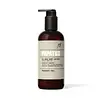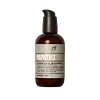What's inside
What's inside
 Key Ingredients
Key Ingredients

 Benefits
Benefits

 Concerns
Concerns

 Ingredients Side-by-side
Ingredients Side-by-side

Water
Skin ConditioningAcetamidoethoxyethanol
HumectantZea Mays Starch
AbsorbentDimethicone/Vinyl Dimethicone Crosspolymer
Skin ConditioningPropanediol
SolventNiacinamide
SmoothingCeramide NP
Skin ConditioningCaprylic/Capric Triglyceride
MaskingEthylhexylglycerin
Skin ConditioningPhenoxyethanol
PreservativeCarbomer
Emulsion StabilisingSodium Hydroxide
BufferingSilica
AbrasiveZinc Gluconate
Skin ConditioningButylene Glycol
HumectantPolyglyceryl-10 Stearate
Skin ConditioningHydrogenated Lecithin
EmulsifyingSucrose Stearate
EmollientTocopherol
AntioxidantWater, Acetamidoethoxyethanol, Zea Mays Starch, Dimethicone/Vinyl Dimethicone Crosspolymer, Propanediol, Niacinamide, Ceramide NP, Caprylic/Capric Triglyceride, Ethylhexylglycerin, Phenoxyethanol, Carbomer, Sodium Hydroxide, Silica, Zinc Gluconate, Butylene Glycol, Polyglyceryl-10 Stearate, Hydrogenated Lecithin, Sucrose Stearate, Tocopherol
Water
Skin ConditioningDicaprylyl Carbonate
EmollientGlycerin
HumectantC13-15 Alkane
SolventGlyceryl Stearate Se
EmulsifyingCetyl Esters
EmollientSqualane
EmollientStearyl Alcohol
EmollientNiacinamide
SmoothingCeramide NP
Skin ConditioningSodium Hyaluronate
HumectantAvena Sativa Kernel Extract
AbrasiveSodium PCA
HumectantHibiscus Sabdariffa Flower Extract
Skin ConditioningPlumeria Acutifolia Flower Extract
Skin ConditioningHydroxyproline
Skin ConditioningProline
Skin ConditioningAloe Barbadensis Leaf Juice
Skin ConditioningChlorphenesin
AntimicrobialPanthenol
Skin ConditioningCetearyl Olivate
Sorbitan Olivate
EmulsifyingHydroxyethyl Acrylate/Sodium Acryloyldimethyl Taurate Copolymer
Emulsion StabilisingTrisodium Ethylenediamine Disuccinate
Sodium Stearoyl Glutamate
CleansingPhenoxyethanol
PreservativeSodium Citrate
BufferingEthylhexylglycerin
Skin ConditioningSorbitan Isostearate
EmulsifyingTocopheryl Acetate
AntioxidantSodium Hydroxide
BufferingPotassium Sorbate
PreservativeCitric Acid
BufferingTocopherol
AntioxidantSodium Benzoate
MaskingWater, Dicaprylyl Carbonate, Glycerin, C13-15 Alkane, Glyceryl Stearate Se, Cetyl Esters, Squalane, Stearyl Alcohol, Niacinamide, Ceramide NP, Sodium Hyaluronate, Avena Sativa Kernel Extract, Sodium PCA, Hibiscus Sabdariffa Flower Extract, Plumeria Acutifolia Flower Extract, Hydroxyproline, Proline, Aloe Barbadensis Leaf Juice, Chlorphenesin, Panthenol, Cetearyl Olivate, Sorbitan Olivate, Hydroxyethyl Acrylate/Sodium Acryloyldimethyl Taurate Copolymer, Trisodium Ethylenediamine Disuccinate, Sodium Stearoyl Glutamate, Phenoxyethanol, Sodium Citrate, Ethylhexylglycerin, Sorbitan Isostearate, Tocopheryl Acetate, Sodium Hydroxide, Potassium Sorbate, Citric Acid, Tocopherol, Sodium Benzoate
Ingredients Explained
These ingredients are found in both products.
Ingredients higher up in an ingredient list are typically present in a larger amount.
Ceramide NP is a type of ceramide and formally known as ceramide 3.
Ceramides are intercellular lipids naturally found in our skin that bonds dead skin cells together to create a barrier. They are known for their ability to hold water and thus are a great ingredient for dry skin.
Ceramides are an important building block for our skin barrier. A stronger barrier helps the skin look more firm and hydrated. By bolstering the skin ceramides act as a barrier against irritating ingredients. This can help with inflammation as well.
If you would like to eat ceramides, sweet potatoes contain a small amount.
Read more about other common types of ceramides here:
Ceramide AP
Ceramide EOP
Ethylhexylglycerin (we can't pronounce this either) is commonly used as a preservative and skin softener. It is derived from glyceryl.
You might see Ethylhexylglycerin often paired with other preservatives such as phenoxyethanol. Ethylhexylglycerin has been found to increase the effectiveness of these other preservatives.
Niacinamide is a multitasking form of vitamin B3 that strengthens the skin barrier, reduces pores and dark spots, regulates oil, and improves signs of aging.
And the best part? It's gentle and well-tolerated by most skin types, including sensitive and reactive skin.
You might have heard of "niacin flush", or the reddening of skin that causes itchiness. Niacinamide has not been found to cause this.
In very rare cases, some individuals may not be able to tolerate niacinamide at all or experience an allergic reaction to it.
If you are experiencing flaking, irritation, and dryness with this ingredient, be sure to double check all your products as this ingredient can be found in all categories of skincare.
When incorporating niacinamide into your routine, look out for concentration amounts. Typically, 5% niacinamide provides benefits such as fading dark spots. However, if you have sensitive skin, it is better to begin with a smaller concentration.
When you apply niacinamide to your skin, your body converts it into nicotinamide adenine dinucleotide (NAD). NAD is an essential coenzyme that is already found in your cells as "fuel" and powers countless biological processes.
In your skin, NAD helps repair cell damage, produce new healthy cells, support collagen production, strengthen the skin barrier, and fight environmental stressors (like UV and pollution).
Our natural NAD levels start to decline with age, leading to slower skin repair, visible aging, and a weaker skin barrier. By providing your skin niacinamide, you're recharging your skin's NAD levels. This leads to stronger, healthier, and younger looking skin.
Another name for vitamin B3 is nicotinamide. This vitamin is water-soluble and our bodies don't store it. We obtain Vitamin B3 from either food or skincare. Meat, fish, wheat, yeast, and leafy greens contain vitamin B3.
The type of niacinamide used in skincare is synthetically created.
Learn more about NiacinamidePhenoxyethanol is a preservative that has germicide, antimicrobial, and aromatic properties. Studies show that phenoxyethanol can prevent microbial growth. By itself, it has a scent that is similar to that of a rose.
It's often used in formulations along with Caprylyl Glycol to preserve the shelf life of products.
Sodium Hydroxide is also known as lye or caustic soda. It is used to adjust the pH of products; many ingredients require a specific pH to be effective.
In small amounts, sodium hydroxide is considered safe to use. However, large amounts may cause chemical burns due to its high alkaline.
Your skin has a natural pH and acid mantle. This acid mantle helps prevent harmful bacteria from breaking through. The acid mantle also helps keep your skin hydrated.
"Alkaline" refers to a high pH level. A low pH level would be considered acidic.
Learn more about Sodium HydroxideTocopherol (also known as Vitamin E) is a common antioxidant used to help protect the skin from free-radicals and strengthen the skin barrier. It's also fat soluble - this means our skin is great at absorbing it.
Vitamin E also helps keep your natural skin lipids healthy. Your lipid skin barrier naturally consists of lipids, ceramides, and fatty acids. Vitamin E offers extra protection for your skin’s lipid barrier, keeping your skin healthy and nourished.
Another benefit is a bit of UV protection. Vitamin E helps reduce the damage caused by UVB rays. (It should not replace your sunscreen). Combining it with Vitamin C can decrease sunburned cells and hyperpigmentation after UV exposure.
You might have noticed Vitamin E + C often paired together. This is because it is great at stabilizing Vitamin C. Using the two together helps increase the effectiveness of both ingredients.
There are often claims that Vitamin E can reduce/prevent scarring, but these claims haven't been confirmed by scientific research.
Learn more about TocopherolWater. It's the most common cosmetic ingredient of all. You'll usually see it at the top of ingredient lists, meaning that it makes up the largest part of the product.
So why is it so popular? Water most often acts as a solvent - this means that it helps dissolve other ingredients into the formulation.
You'll also recognize water as that liquid we all need to stay alive. If you see this, drink a glass of water. Stay hydrated!
Learn more about Water